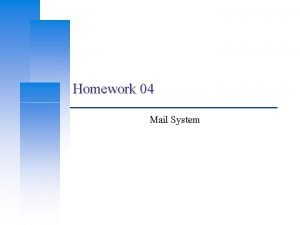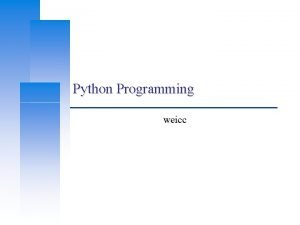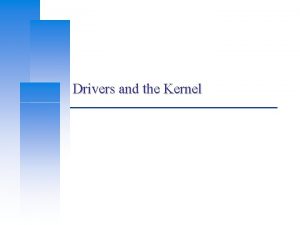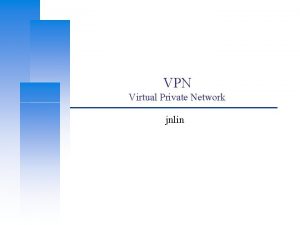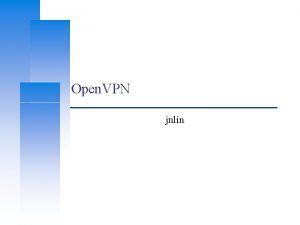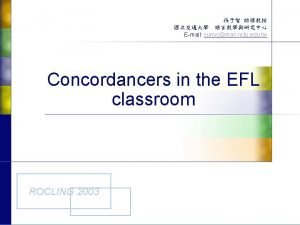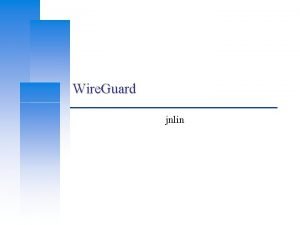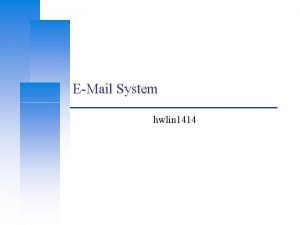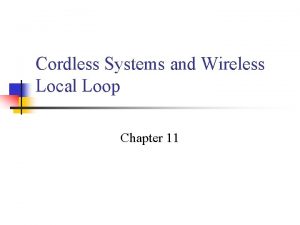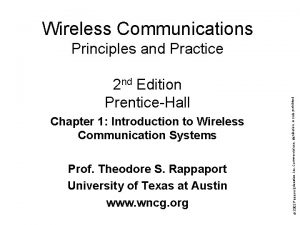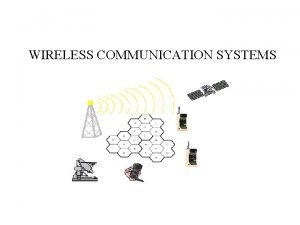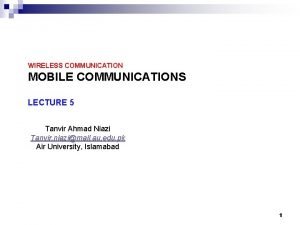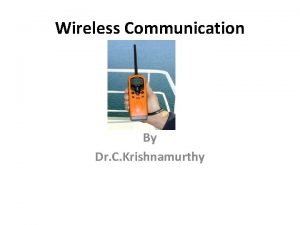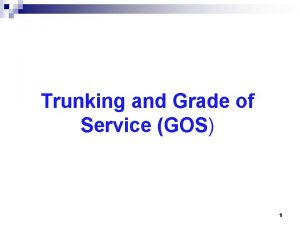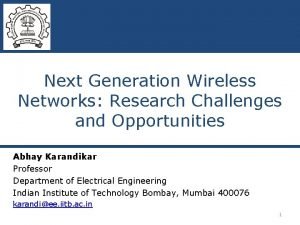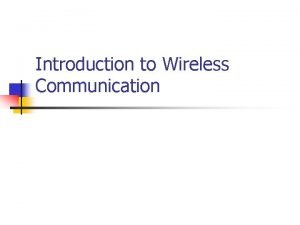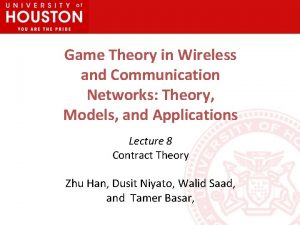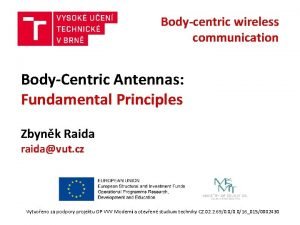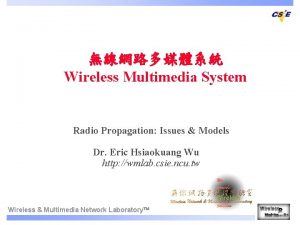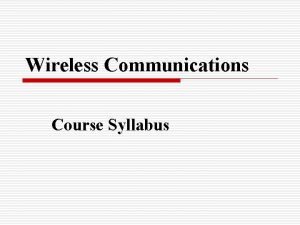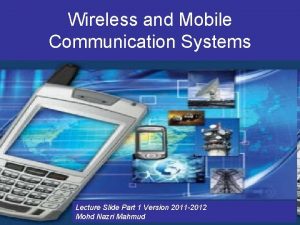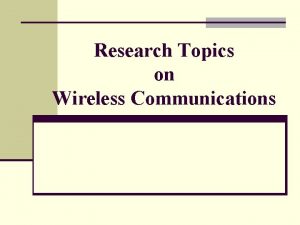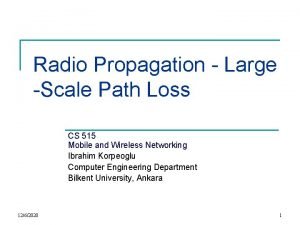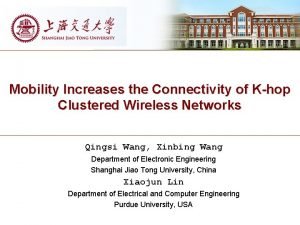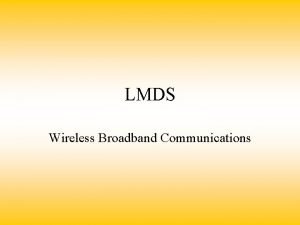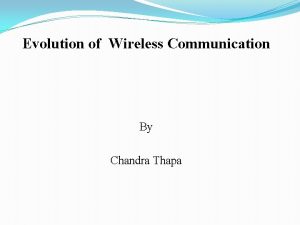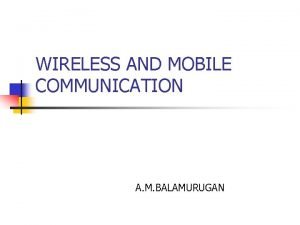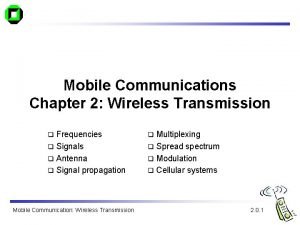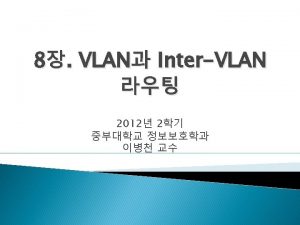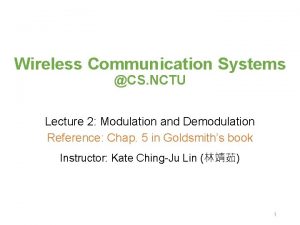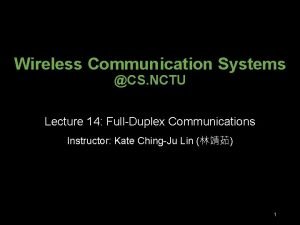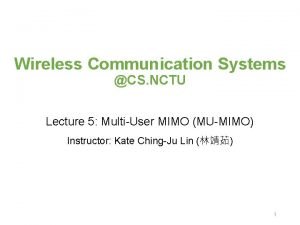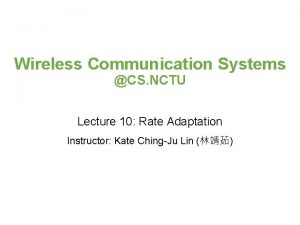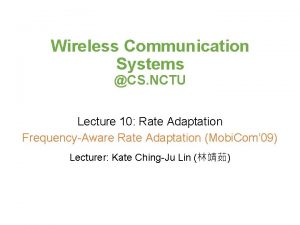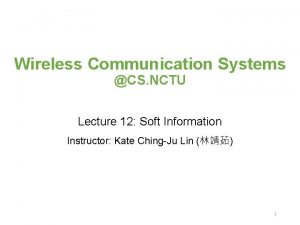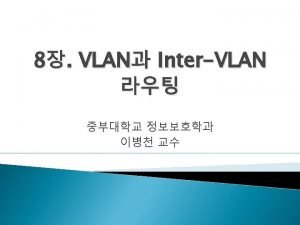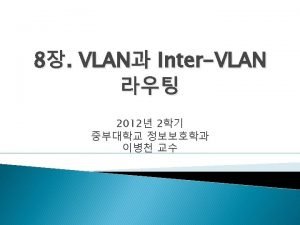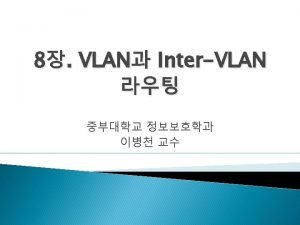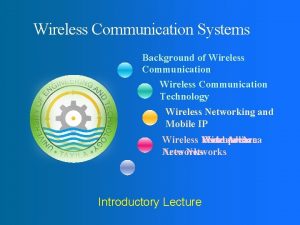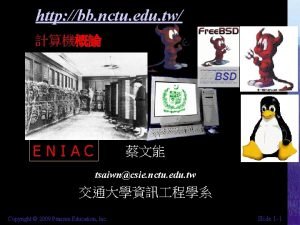Wireless Communication Systems CS NCTU Lecture 9 MAC











































- Slides: 43

Wireless Communication Systems @CS. NCTU Lecture 9: MAC Protocols for WLANs Instructor: Kate Ching-Ju Lin (林靖茹) 1

Reference 1. A Technical Tutorial on the IEEE 802. 11 Protocol By Pablo Brenner online: http: //www. sss-mag. com/pdf/802_11 tut. pdf 2. IEEE 802. 11 Tutorial By Mustafa Ergen online: http: //wow. eecs. berkeley. edu/ergen/docs/ieee. pdf 3. 802. 11 Wireless Networks: The Definitive Guide By Matthew Gast 4. 802. 11 ac: A Survival Guide By Matthew Gast online: http: //chimera. labs. oreilly. com/books/1234000001739

Agenda • • • Basic 802. 11 Operation Collision Avoidance (CSMA/CA) Hidden Terminal Qo. S guarantee Other Issues Performance Analysis 3

Why MAC for WLANs is Challenging? • Wireless medium is prone to errors • One station cannot “hear” all other stations �Local view != global view • Channel quality, and thereby the achievable data rate, is closely related to link distance, and could change with time due to mobility • Again, because of mobility, need management mechanisms to (de)associating with APs as location changes �Need efficient handoff to ensure seamless access 4

What is MAC? • Medium access control • Layer 2 (link layer) • Allowing multiple stations in a network to share the spectrum resources and communicate (1 -hop) • Type of communications �Unicast: one-to-one LLC MSDU MAC MPDU PSDU �Multicast: one-to-many PHY �Broadcast: one-to-all STA 1 MSDU MAC PSDU PPDU PHY STA 2 5

Basic Service Set (BSS) • BSS �Basic building block �Infrastructure mode • IBSS (independent BSS) �Ad-hoc network • ESS (extended service set) �Formed by interconnected BSSs 6

Infrastructure Mode AP BSS (Basic Service Set) STA • Each station (STA) associates with a central station Access point (AP) • An AP and its stations form a basic service set (BSS) • AP announces beacons periodically 7

Infrastructure Mode ESS (Extended Service Set) AP AP STA • Several BSSs could form an ESS • A roaming user can move from one BSS to another within the ESS by re-association 8

Infrastructure Mode ESS (Extended Service Set) AP AP STA • Issues �Inter-BSS interference: via proper channel assignment �Load balancing: via user management 9

Ad-Hoc Networks IBSS (independent BSS) • Clients form a peer-to-peer network without a centralized coordinator • Clients communicate with each other via multi-hop routing �Will introduce ad-hoc routing 10

Beacon and Association 100 ms • The AP in each BSS broadcasts beacon frames periodically (every 100 ms by default) • Each beacons includes information such as SSID and AP’s address • A STA discovers a BSS by switching channels and scanning to look for beacons Associate 11

Two Operational Modes • Distributed coordination function (DCF) �Stations contend for transmission opportunities in a distributed way �Rely on CSMA/CA • Point coordination function (PCF) �AP sends poll frames to trigger transmissions in a centralized manner Less used

CSMA/CA diff same • Carrier sense multiple access with collision avoidance • Similarity and difference between CSMA/CD and CSMA/CA �Both allow a STA to send if the medium is sensed to be “idle” �Both defer transmission if the medium is sensed to be “busy” �CD: immediately stop the transmission if a collision is detected �CA: apply random backoff to avoid collisions! Why? a half-duplex STA cannot detect collisions during transmission 13

DCF • Start contention after the channel keeps idle for DIFS • Avoid collisions via random backoff • AP responds ACK if the frame is delivered correctly (i. e. , passing the CRC check) No NACK • Retransmit the frame until the retry limit is reached 14

Prioritized Interframe Spacing Find specific timing in the Spec. or Wiki • Latency: Priority: SIFS < PIFS < DIFS SIFS > PIFS > DIFS • SIFS (Short interframe space): control frames, e. g. , ACK and CTS • PIFS (PCF interframe space): CF-Poll • DIFS (DCF interframe space): data frame 15

Frame Format Data ACK Check other frame format in Spec. • How to estimate protocol overhead without considering backoff � 1 - TData / (TDIFS + TPLCP + TMAC + TData + TSIFS + TACK) �Control frames are sent at the base rate (lowest bit 16 rate)

Overhead vs. Throughput • Effective throughput number of successfully delivered bits total occupied time • Packet size vs. Effective throughput ? header ✘ header tail 1500 -byte data 1 -byte data tail Effective throughput ~ 0 • Bit-rate vs. Effective throughput header 1500 -byte data sent at 24 mb/s 1500 -byte data Sent at 48 mb/s (halve the tx time) tail Throughput(48) != 2 x Throughput (24) 17

Fragmentation and Aggregation • Success probability v. s. frame size �Large frame reduces overhead, but is less reliable �Discard the frame even if only one bit is in error �Packet delivery ratio of an N-bit packet: (1 -BER)N • Fragmentation �Break a frame into small pieces �All are of the same size, except for the last one �Interference only affects small fragments • Aggregation �Aggregate multiple small frames in order to reduce the overhead �Supported in 802. 11 e and 802. 11 n

Agenda • • • Basic 802. 11 Operation Collision Avoidance Hidden Terminal Qo. S guarantee Other Issues Performance Analysis 19

Random Backoff • STAs listen to the channel before transmission after DIFS • Avoid collision by random backoff 20

Exponential Random Backoff 1. Each STA maintains a contention window �Initialized to CWmin = 32 2. 3. 4. 5. Randomly pick a number, say k, between [0, CW-1] Count down from k when the channel becomes idle Start transmission when k = 0 if the channel is still idle Double CW for every unsuccessful transmission, up to CWmax (1024) 6. CW is reset to CWmin after every successful transmission When will collisions occur? What’s the probability a collision occurs? 21

Agenda • • • Basic 802. 11 Operation Collision Avoidance Hidden Terminal Qo. S guarantee Other Issues Performance Analysis 22

Hidden Terminal Problem • Two nodes hidden to each other transmit at the same time, leading to collision

802. 11’s Solution: RTS/CTS AP STA 2 STA 1 • STA 1 sends RTS whenever it wins contention • AP broadcasts CTS • Other STAs that receive CTS defer their transmissions

802. 11’s Solution: RTS/CTS NAV (Network allocation vector): STA performs virtual carrier sense for the specified time interval Usually disabled in practice due to its expensive overhead

Recent Solutions to Hidden Terminals • Embrace collisions and try to decode collisions �Zig. Zag decoding �S. Gollakota and D. Katabi, “Zig. Zag decoding: combating hidden terminals in wireless networks, ” ACM SIGCOMM, 2008 • Rateless code �Continuously aggregate frames and stop until decoding succeeds �A. Gudipati and S. Katti, “Strider: automatic rate adaptation and collision handling, ” ACM SIGCOMM, 2011 26

Agenda • • • Basic 802. 11 Operation Collision Avoidance Hidden Terminal Qo. S guarantee Other Issues Performance Analysis 27

802. 11 Family • 802. 11 a/b/g: conventional DCF • 802. 11 e: support quality of service (Qo. S) enhancements for wireless LANs • 802. 11 n: support single-user MIMO (lecture 4) • 802. 11 ac: support multi-user MIMO (lecture 5) • 802. 11 ad: define a new physical layer in the 60 GHz (mm. Wave, last lecture) • 802. 11 p: for vehicular networks 28

802. 11 e EDCA MAC • Enhance distributed channel access (EDCA) • Support prioritized quality of service (Qo. S) • Define four access categories (ACs) priority low high 29

802. 11 e EDCA MAC – Priority Queues Manage frames using priority queues 30

How to Prioritize Frames in 802. 11 e? • Again, by controlling the waiting time �A higher-priority frame waits for shorter time �Frames with the same priority contend as usual priority high low 31

How to Prioritize Frames in 802. 11 e? • Again, by controlling the waiting time �A higher-priority frame waits for shorter time �Frames with the same priority contend as usual • AIFS (Arbitration Inter-Frame Spacing) probabilistic guarantee (Within an AC) (between ACs) 32

Agenda • • • Basic 802. 11 Operation Collision Avoidance Hidden Terminal Qo. S guarantee Other Issue Performance Analysis 33

Other Issues • Performance anomaly �M. Heusse, et al. , "Performance anomaly of 802. 11 b, " IEEE INFOCOM, 2003 • Expensive overhead as the PHY rate increases �K. Tan, et al. , "Fine-grained channel access in wireless LAN, " ACM SIGCOMM, 2011 �S. Sen, et al. , “No time to countdown: migrating backoff to the frequency domain, ” ACM Mobi. Com, 2011 § Unequal band-width and flexible channelization � 20 MHz in 802. 11 a/b/g/n/ac, 40 MHz in 802. 11 n/ac, 80 MHz and 160 Hz in 802. 11 ac �S. Rayanchu, et al. , ”FLUID: improving throughputs in enterprise wireless LANs through flexible channelization, “ ACM MOBICOM, 2012

Performance Anomaly • The throughput of a STA sending at a high rate (e. g. , 54 Mbps) is degraded by that sending at a low rate (e. g. , 6 Mbps) • Root causes? � 802. 11 supports multiple transmission bit-rates, each of which has a different modulation and coding scheme � 802. 11 ensure packet fairness, instead of time fairness Packet fairness: each STA has an equal probability to win the contention the average number of delivered packets for all STAs are roughly the same (802. 11) Time fairness: each STA occupies roughly the same proportion of channel time 35

Performance Anomaly rij=54 Mb/s ruv=6 Mb/s b 54=36. 2 Mb/s when l 54 sends alone c 54=4. 14 Mb/s as contending with l 6 b 6=5. 4 Mb/s when l 6 sends alone c 6=4. 37 Mb/s as contending with l 54 p/b 6 t Channel is almost occupied by low-rate links Everyone gets a similar throughput, regardless of its bit-rate

Agenda • • • Basic 802. 11 Operation Collision Avoidance Hidden Terminal Qo. S guarantee Other Issues Performance Analysis 37

Performance Analysis for CSMA/CA G. Bianchi, "Performance analysis of the IEEE 802. 11 distributed coordination function, " Selected Areas in Communications, IEEE Journal on 18, no. 3 (2000): 535 -547 • Model to compute the 802. 11 DCF throughput • Assumptions �Finite number of stations �Ideal channel, i. e. , no packet errors and no hidden terminals �Consider “saturation throughput”, i. e. , the maximal load a system can achieve • Core ideas: �At each transmission attempt (either first transmission or retransmissions), each packet collides with constant and independent probability p �p: conditional probability related to contention window W and number of stations N

Performance Analysis for CSMA/CA Model as a bi-dimensional discrete-time Markov chain {s(t), b(t)} s(t): backoff stage at time t, b(t): backoff time counter at time t Random backoff Stage 0 count down succeed Stage 1 Stage m fail

Performance Analysis for CSMA/CA Model as a bi-dimensional discrete-time Markov chain {s(t), b(t)} s(t): backoff stage at time t, b(t): backoff time counter at time t Random backoff Stage 0 count down succeed Stage 1 Stage m fail Find the stationary distribution of the chain: bi, k = limt ∞P{s(t)=i, s(t)=k}

Performance Analysis for CSMA/CA • Find the stationary distribution of the chain • The probability that a station transmits in a randomly chosen slot time • The probability that there is at least one transmission • The success probability of a transmission

Summary • Nice properties of Wi. Fi �Unlicensed band Free!! �Distributed random access and no coordination �Ensuring fairness • Common issues �Expensive overhead and lower spectrum efficiency �Hard to avoid collisions �No Qo. S guarantee Every protocol balances the trade-off between performance and overhead

Quiz • Assume the control frames and the overhead occupies the channel time of 100 us • Compare throughput if a 135 -byte (1080 bits) packet is sent at 6 Mb/s and 54 Mb/s, respectively �(Hint: 1080/54 = 20, 1080/6=180) 43
 Telecommunications, the internet, and wireless technology
Telecommunications, the internet, and wireless technology Sources of macbeth
Sources of macbeth Mac mac o kok dac
Mac mac o kok dac 01:640:244 lecture notes - lecture 15: plat, idah, farad
01:640:244 lecture notes - lecture 15: plat, idah, farad Nctu gatwa
Nctu gatwa Ntcu tld
Ntcu tld Nctu domain
Nctu domain Nfc nctu
Nfc nctu Irssi screen
Irssi screen Weicc
Weicc Ok nctu
Ok nctu Nctu ok
Nctu ok Nctu pulse secure
Nctu pulse secure Screen irssi
Screen irssi Nctu vpn
Nctu vpn Csie.nctu.edu.tw webmail
Csie.nctu.edu.tw webmail Nctu vpn
Nctu vpn Nctu electrophysics
Nctu electrophysics Computer center
Computer center Computer center
Computer center Ul nurse call system testing
Ul nurse call system testing Dect protocol architecture
Dect protocol architecture Wireless communication introduction
Wireless communication introduction Page in wireless communication
Page in wireless communication Cell dragging in wireless communication
Cell dragging in wireless communication Advantages of wireless communication
Advantages of wireless communication Trunking and grade of service in wireless communication
Trunking and grade of service in wireless communication Next generation wireless communication market
Next generation wireless communication market History of wireless technology
History of wireless technology Game theory in wireless and communication networks
Game theory in wireless and communication networks Stanford wireless communication
Stanford wireless communication Cdpd in wireless communication
Cdpd in wireless communication Fundamental principles of wireless communication
Fundamental principles of wireless communication Free space propagation model in wireless communication
Free space propagation model in wireless communication Wireless communication course syllabus
Wireless communication course syllabus Large scale fading in wireless communication
Large scale fading in wireless communication Wireless communication research topics
Wireless communication research topics 515
515 Free space propagation model in wireless communication
Free space propagation model in wireless communication Microcontroller wireless communication
Microcontroller wireless communication Lmds architecture
Lmds architecture Evolution of wireless communication
Evolution of wireless communication Mobile communication syllabus
Mobile communication syllabus Wireless communication
Wireless communication





